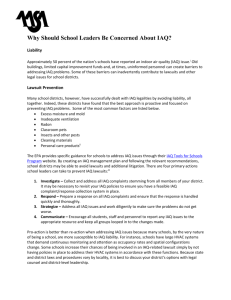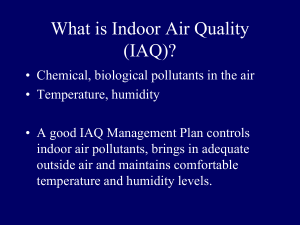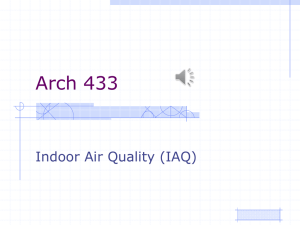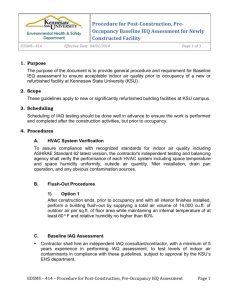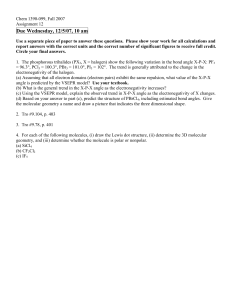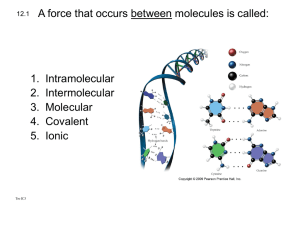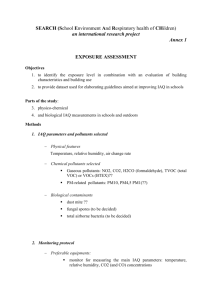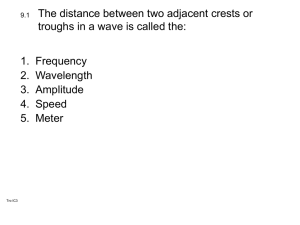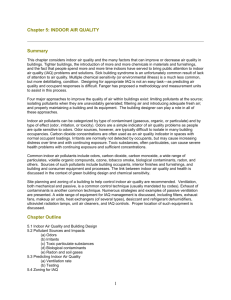In-Class Questions
advertisement
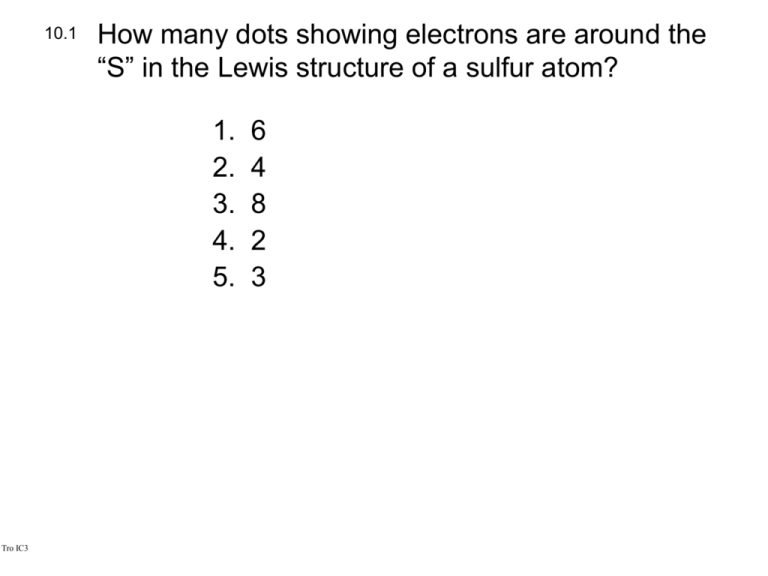
10.1 How many dots showing electrons are around the “S” in the Lewis structure of a sulfur atom? 1. 2. 3. 4. 5. Tro IC3 6 4 8 2 3 10.1 How many dots showing electrons are around the “S” in the Lewis structure of a sulfur atom? 1. 2. 3. 4. 5. Tro IC3 6 4 8 2 3 10.2 When electrons are completely transferred from one atom to another, the bond between the ions is called: 1. 2. 3. 4. 5. Tro IC3 Polar covalent Ionic Polar ionic Nonpolar covalent Covalent 10.2 When electrons are completely transferred from one atom to another, the bond between the ions is called: 1. 2. 3. 4. 5. Tro IC3 Polar covalent Ionic Polar ionic Nonpolar covalent Covalent 10.3 Use Lewis theory to predict the chemical formula of the product formed by the reaction between aluminum and atomic oxygen. 1. 2. 3. 4. 5. Tro IC3 AlO Al3O Al3O2 Al2O3 Al3O3 10.3 Use Lewis theory to predict the chemical formula of the product formed by the reaction between aluminum and atomic oxygen. 1. 2. 3. 4. 5. Tro IC3 AlO Al3O Al3O2 Al2O3 Al3O3 10.4 How many paired electrons are in the Lewis structure of lithium nitride? 1. 2. 3. 4. 5. Tro IC3 3 5 8 4 0 10.4 How many paired electrons are in the Lewis structure of lithium nitride? 1. 2. 3. 4. 5. Tro IC3 3 5 8 4 0 10.5 How many valence electrons are there in one silicon atom? 1. 2. 3. 4. 5. Tro IC3 3 6 14 4 8 10.5 How many valence electrons are there in one silicon atom? 1. 2. 3. 4. 5. Tro IC3 3 6 14 4 8 10.6 How many electrons must a phosphorus atom gain in order to have a full valence shell? 1. 2. 3. 4. 5. Tro IC3 2 3 1 5 0 10.6 How many electrons must a phosphorus atom gain in order to have a full valence shell? 1. 2. 3. 4. 5. Tro IC3 2 3 1 5 0 10.7 How many electrons are there in the outer shell of an oxide ion? 1. 2. 3. 4. 5. Tro IC3 8 2 4 6 0 10.7 How many electrons are there in the outer shell of an oxide ion? 1. 2. 3. 4. 5. Tro IC3 8 2 4 6 0 10.8 How many resonance structures are possible for the nitrate ion? 1. 2. 3. 4. 5. Tro IC3 1 3 0 4 2 10.8 How many resonance structures are possible for the nitrate ion? 1. 2. 3. 4. 5. Tro IC3 1 3 0 4 2 10.9 How many bonding pairs of electrons are in one molecule of ammonia? 1. 2. 3. 4. 5. Tro IC3 1 2 3 4 0 10.9 How many bonding pairs of electrons are in one molecule of ammonia? 1. 2. 3. 4. 5. Tro IC3 1 2 3 4 0 10.10 How many lone pairs of electrons are in one molecule of carbon tetrachloride? 1. 2. 3. 4. 5. Tro IC3 4 6 0 8 12 10.10 How many lone pairs of electrons are in one molecule of carbon tetrachloride? 1. 2. 3. 4. 5. Tro IC3 4 6 0 8 12 10.11 Which of the following contains one or more double bonds? 1. 2. 3. 4. 5. Tro IC3 F2 N2 CN1CO SiO2 10.11 Which of the following contains one or more double bonds? 1. 2. 3. 4. 5. Tro IC3 F2 N2 CN1CO SiO2 10.12 Which of the following contains a triple bond? 1. 2. 3. 4. 5. Tro IC3 C2H2 H2 OF2 CF4 OH1- 10.12 Which of the following contains a triple bond? 1. 2. 3. 4. 5. Tro IC3 C2H2 H2 OF2 CF4 OH1- 10.13 How many lone pairs are around the central atom in carbon tetrachloride? 1. 2. 3. 4. 5. Tro IC3 1 4 0 12 16 10.13 How many lone pairs are around the central atom in carbon tetrachloride? 1. 2. 3. 4. 5. Tro IC3 1 4 0 12 16 10.14 What is the bond angle in a sulfur dioxide molecule? 1. 2. 3. 4. 5. Tro IC3 180° 120° 90° 109.5° 104° 10.14 What is the bond angle in a sulfur dioxide molecule? 1. 2. 3. 4. 5. Tro IC3 180° 120° 90° 109.5° 104° 10.15 What is the electron geometry of boron trifluoride? 1. 2. 3. 4. 5. Tro IC3 Linear Trigonal planar Tetrahedral Trigonal pyramidal Bent 10.15 What is the electron geometry of boron trifluoride? 1. 2. 3. 4. 5. Tro IC3 Linear Trigonal planar Tetrahedral Trigonal pyramidal Bent 10.16 What would be the shape of NH21–? 1. 2. 3. 4. 5. Tro IC3 Linear Trigonal planar Tetrahedral Trigonal pyramidal Bent 10.16 What would be the shape of NH21–? 1. 2. 3. 4. 5. Tro IC3 Linear Trigonal planar Tetrahedral Trigonal pyramidal Bent 10.17 What is the electron geometry of a compound when the central atom is surrounded by 3 single bonds and 1 lone pair? 1. 2. 3. 4. 5. Tro IC3 Linear Trigonal planar Tetrahedral Trigonal pyramidal Bent 10.17 What is the electron geometry of a compound when the central atom is surrounded by 3 single bonds and 1 lone pair? 1. 2. 3. 4. 5. Tro IC3 Linear Trigonal planar Tetrahedral Trigonal pyramidal Bent 10.18 Which of the following is most soluble in water? 1. 2. 3. 4. 5. Tro IC3 CH3OH CO2 C2H4 F2 CCl4 10.18 Which of the following is most soluble in water? 1. 2. 3. 4. 5. Tro IC3 CH3OH CO2 C2H4 F2 CCl4 10.19 Which of the following has a central atom that often does not obey the octet rule? 1. 2. 3. 4. 5. Tro IC3 CH4 BF3 CCl4 NO3 NH41+ 10.19 Which of the following has a central atom that often does not obey the octet rule? 1. 2. 3. 4. 5. Tro IC3 CH4 BF3 CCl4 NO3 NH41+ 10.20 Which of the following contain a nonpolar, purely covalent bond? 1. 2. 3. 4. 5. Tro IC3 NH3 CaCl2 I2 CO2 CO 10.20 Which of the following contain a nonpolar, purely covalent bond? 1. 2. 3. 4. 5. Tro IC3 NH3 CaCl2 I2 CO2 CO 10.21 Which of the following molecules contain one or more polar covalent bonds, but is nonpolar? 1. 2. 3. 4. 5. Tro IC3 CO N2 H2O HF SiO2 10.21 Which of the following molecules contain one or more polar covalent bonds, but is nonpolar? 1. 2. 3. 4. 5. Tro IC3 CO N2 H2O HF SiO2 10.22 Which of the following is the most soluble in gasoline (C8H18)? 1. 2. 3. 4. 5. Tro IC3 H2O HCl NH3 CF4 NaCl 10.22 Which of the following is the most soluble in gasoline (C8H18)? 1. 2. 3. 4. 5. Tro IC3 H2O HCl NH3 CF4 NaCl 10.23 Tro IC3 Arrange the following elements in order of increasing electronegativity (lowest first): Cl, Te, Se, Sr, and Ba. Do NOT use a table of numeric electronegativity values. 1. Cl, Te, Se, Sr, Ba 2. Cl, Te, Se, Ba, Sr 3. Ba, Sr, Te, Se, Cl 4. Sr, Ba, Te, Se, Cl 5. Ba, Sr, Se, Te, Cl 10.23 Tro IC3 Arrange the following elements in order of increasing electronegativity (lowest first): Cl, Te, Se, Sr, and Ba. Do NOT use a table of numeric electronegativity values. 1. Cl, Te, Se, Sr, Ba 2. Cl, Te, Se, Ba, Sr 3. Ba, Sr, Te, Se, Cl 4. Sr, Ba, Te, Se, Cl 5. Ba, Sr, Se, Te, Cl 10.24 Tro IC3 What is the basic structure of a soap molecule or ion? 1. A long polar tail and a nonpolar head that are water- and membrane-soluble, respectively 2. A long nonpolar tail that is water-soluble 3. A polar head that is membrane-soluble 4. A long nonpolar tail and a polar head that are membrane- and water-soluble, respectively 5. Two of the above 10.24 Tro IC3 What is the basic structure of a soap molecule or ion? 1. A long polar tail and a nonpolar head that are water- and membrane-soluble, respectively 2. A long nonpolar tail that is water-soluble 3. A polar head that is membrane-soluble 4. A long nonpolar tail and a polar head that are membrane- and water-soluble, respectively 5. Two of the above
